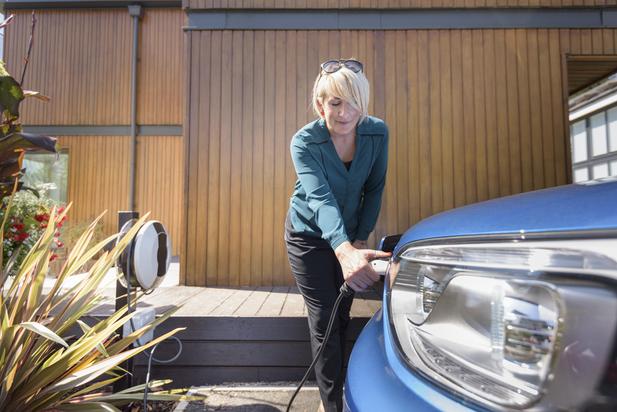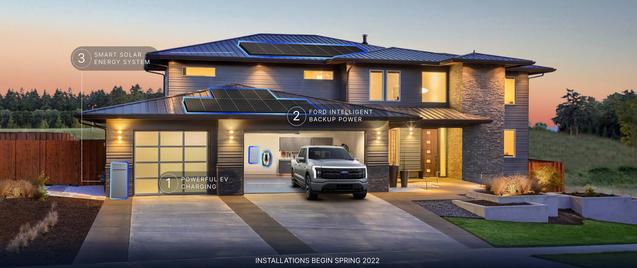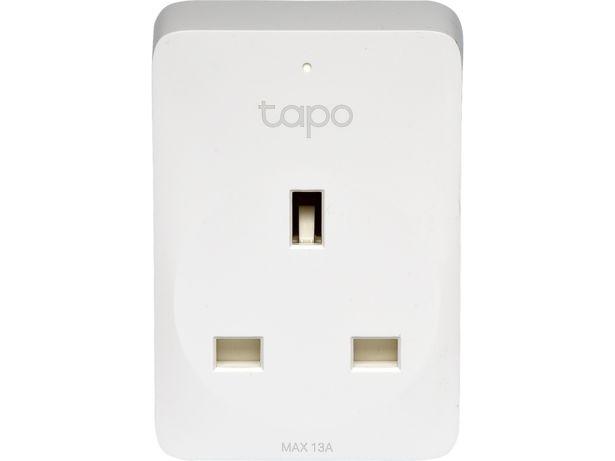Ford, GM, & PG&E To Begin Vehicle-To-Grid Trials
Pacific Gas & Electric, the principle supplier of electricity in northern California, announced last week it will begin working with Ford and General Motors to test how vehicle-to-grid and vehicle-to-home systems could benefit consumers and the utility company in the future, according to ArsTechnica.
How would that work? Whole house energy storage batteries are expensive and can only supply backup electricity for a fairly limited time. By contrast, the battery in an electric vehicle is quite large and could supply electricity to a home or small business for several days, assuming the homeowner is somewhat frugal in deciding what items need powering during a blackout. Air conditioning and heat? Sure. Keeping the hot tub at 104º? Not so much.
Vehicle-To-Home
The most likely use case is a vehicle-to-home (V2H) system that uses the electricity stored in a vehicle battery to keep the lights on in a residence during a power outage. There is a catch, however. In order for the system to work, there must be a way to disconnect the breaker panel from the electrical grid to protect repair workers from electrical shocks while they work to get the grid functioning again.
There are mechanical ways of doing this, but most people will prefer a so-called transfer switch that isolates the home automatically. Adding another source of electricity to your home’s entry panel will also require the services of a licensed electrician. All of this rejiggering of your home’s electrical service can be pricey. Ford has chosen Sunrun as its partner to work with homeowners to find a professional who will do the work at a price that is reasonable.
Vehicle-To-Grid
Your car’s battery can also be used to send power back to the grid, a process that could potentially allow drivers to make some money by selling electricity back to utility companies. The rules for doing this vary considerably from state to state. In general, the utility industry is opposed to such schemes and is always trying to find ways to discourage them, but that may be changing.

Virtual Power Plant
Utilities need massive amounts of battery storage to support their renewable energy goals. California today has more than 1 million electric cars on its roads. Assuming each one has at least a 50 kWh battery, that means there is a total of 50 gigawatt-hours of energy storage (Readers, please check my math. You know I struggle with basic arithmetic.) available within the state at any given time. What if all those batteries could soak up excess renewable energy which would otherwise be wasted and give it back to the grid when the flow of electricity from renewables declines? That is what is called a virtual power plant and is being trialed with home storage batteries in Vermont and Australia.
A VPP requires a “smart grid,” one in which the utility companies have the power to access all those batteries in real time over the internet to manage the flow of electrons on a second by second basis to balance the needs of the grid and the demand for charging. Instead of having two battery storage systems — one grid scale and the other for transportation — there would be one system that would serve the needs of all stakeholders.
Is that a big ask? Yes it is. But it would automatically slash the need for batteries at a time when there are not enough of them to meet the needs of vehicle manufacturers and utility companies. Voila! Serendipity made possible through artificial intelligence and algorithms. Is it hard? Sure it is. Would it work? Absolutely.
Vehicle-To-Load
A third way to tap the energy stored in vehicle batteries is called vehicle-to-load. This is the simplest system of all. The vehicle is fitted with a number of 110 and 220 volt outlets that can power construction tools or camping gear anywhere, even if the nearest electrical grid is miles away. Sweet!
Trials Coming This Year
PG&E says it will begin clinical trials that lead to actual end user testing later this year to see how all this might work. One problem that comes from writing for CleanTechnica for more than a decade is I often get a sense of deja vu on some topics. For instance, I distinctly remember writing an article a decade ago for a now defunct branch of the CleanTechnica media empire about PG&E partnering with BMW when the i3 first came out to test smart charging systems.
The theory was that having millions of electric cars on the road would strain the electrical grid. The answer was to manage all those charging sessions so the utility company could reduce charging power as needed to support the overall functioning of the grid. Instead of a 1000 EVs all plugging in and calling for maximum power at once, computers would figure out how much electricity to give each car and when. Drivers would determine what state of charge they needed to start the next day and when they planned to begin using their cars. The computer would figure out how to keep everyone happy.
Battery Degradation
GM and Ford seem to be fully on board with V2L, V2H, and V2G capability. Many drivers are intrigued by the idea of having backup power for their homes without listening to the drone of a generator for hours on end. The one thing that no one seems to have a definitive answer to is, what effect does bi-directional charging have on batteries? If a car participated in a V2G scheme on a regular basis, would its battery reach the end of its useful life sooner than the battery in a similar car that does not participate in V2G activities?
Should utility companies compensate drivers for connecting to a vehicle-to-grid program? They are quick enough to charge rooftop solar customers for the so-called “burdens” they impose on the grid. What’s sauce for the goose is sauce for the gander, my old Irish grandmother liked to say.
What About Tesla?
One company that has shown little to no interest in any systems that export power from a vehicle battery is Tesla. Yes, it has a “camp mode” feature that adjusts the temperature and humidity inside the passenger compartment if you want to sleep in your car, but there’s no place to plug in a circular saw. Vehicle to grid? Forget about it, there is no interest in doing that within the hallowed halls of Tesla headquarters. If there is one area where legacy automakers could gain a competitive edge on Tesla, this is it.
Will Tesla see the light? Perhaps. It is slowly starting to consider opening its Supercharger network to all drivers and it has dropped the tri-motor version of the Cybertruck now that Hummer and Rivian have 4-motor models coming. So perhaps V2G and similar systems are under consideration in Palo Alto.
The one thing we can say with some certainty is there is a lot of consumer interest in tapping the energy stored in the batteries of electric cars. It’s an idea that helps people look favorably on the idea of owning an electric car and for that reason alone, it should be pursued. Here’s hoping PG&E won’t dither and diddle for another decade before it decides to make V2H and V2G strategies a normal part of the EV ownership experience.
Appreciate CleanTechnica’s originality? Consider becoming a CleanTechnica Member, Supporter, Technician, or Ambassador — or a patron on Patreon.Have a tip for CleanTechnica, want to advertise, or want to suggest a guest for our CleanTech Talk podcast? Contact us here.



